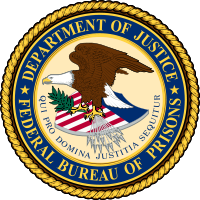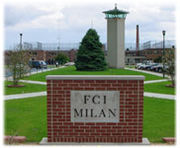Federal Bureau of Prisons
| Federal Bureau of Prisons | |
 |
|
| Seal of the Prisons Department | |
| Agency overview | |
|---|---|
| Formed | 1930 |
| Legal personality | Governmental: Government agency |
| Jurisdictional structure | |
| Federal agency | USA |
| General nature |
|
| Operational structure | |
| Agency executive | Harley G. Lappin, Director |
| Parent agency | United States Department of Justice |
| Website | |
| http://www.bop.gov/ | |

- "FBOP" redirects here. For the former bank holding company, see FBOP Corporation.
The Federal Bureau of Prisons (often referred to operationally as the BOP)[1] is a federal law enforcement agency subdivision of the United States Department of Justice and is responsible for the administration of the federal prison system. The system also handles prisoners who committed acts considered felonies under the District of Columbia's law.
The Bureau was established in 1930 to provide more progressive and humane care for Federal inmates, to professionalize the prison service, and to ensure consistent and centralized administration of the 11 Federal prisons in operation at the time.
According to its official web site, the Bureau consists of more than 119 institutions, 6 regional offices, its headquarters office in Washington D.C.,[2] 2 staff training centers, and 28 community corrections offices, and is responsible for the custody and care of approximately 207,872 Federal offenders. Approximately 85 percent of these inmates are confined in Bureau-operated correctional facilities or detention centers. The remainder are confined through agreements with state and local governments or through contracts with privately-operated community corrections centers, detention centers, prisons, and juvenile facilities.[3]
The Bureau is also responsible for carrying out all judicially mandated federal executions (other than those carried out under military law) in the United States, and maintains the federal lethal injection chamber in Terre Haute, Indiana.
Contents |
History
Before the Bureau of Prisons
The Federal Prison System existed for more than 30 years before the establishment of the Bureau of Prisons. Although its wardens functioned almost autonomously, a Department of Justice official in Washington was nominally in charge of Federal prisons, starting with the passage of the Three Prisons Act in 1891, which authorized the Federal Government's first three penitentiaries.
Until 1907, prison matters were handled by the Justice Department's General Agent. The General Agent was responsible for Justice Department accounts, oversight of internal operations, and certain criminal investigations, as well as prison operations. In 1907, the General Agent's office was abolished, and its functions were distributed among three new offices: the Division of Accounts (which evolved into the Justice Management Division); the Office of the Chief Examiner (which evolved into the Federal Bureau of Investigation); and the Office of the Superintendent of Prisons and Prisoners, later called the Superintendent of Prisons (which evolved into the Bureau of Prisons).
Bureau of Prisons established

Pursuant to Pub. L. No. 71-218, 46 Stat. 325 (1930), the Bureau of Prisons was established within the Department of Justice and charged with the "management and regulation of all Federal penal and correctional institutions." This responsibility covered the administration of the 11 Federal prisons in operation at the time. While time have passed and laws have changed, the Bureau's responsibilities have grown, as has the prison population. At the end of 1930, the agency operated 14 facilities for just over 13,000 inmates. By 1940, the Bureau had grown to 24 facilities with 24,360 inmates. Except for a few fluctuations, the number of inmates did not change significantly between 1940 and 1980, when the population was 24,252. However, the number of facilities almost doubled (from 24 to 44) as the Bureau gradually moved from operating large facilities confining inmates of many security levels to operating smaller facilities that each confined inmates with similar security needs.
As a result of Federal law enforcement efforts and new legislation that dramatically altered sentencing in the Federal criminal justice system, the 1980s brought a significant increase in the number of Federal inmates. The Sentencing Reform Act of 1984 established determinate sentencing, abolished parole, and reduced good time; additionally, several mandatory minimum sentencing provisions were enacted in 1986, 1988, and 1990. From 1980 to 1989, the inmate population more than doubled, from just over 24,000 to almost 58,000. During the 1990s, the population more than doubled again, reaching approximately 136,000 at the end of 1999 as efforts to combat illegal drugs and illegal immigration contributed to significantly increased conviction rates.
Staffing levels also have risen dramatically in recent years. In 1980, the Bureau had approximately 10,000 employees. That number almost doubled in 10 years to just over 19,000 in 1990. As of June 2003, there were about 34,000 employees in the Bureau.
Authority
Bureau of Prisons Officers and employees are granted powers of arrest under Title 18, section 3050 of the United States Code under which they may:
(1) make arrests on or off of Bureau of Prisons property without warrant for violations of the following provisions regardless of where the violation may occur: sections 111 (assaulting officers), 751 (escape), and 752 (assisting escape) of title 18, United States Code, and section 1826 (c) (escape) of title 28, United States Code;
(2) make arrests on Bureau of Prisons premises or reservation land of a penal, detention, or correctional facility without warrant for violations occurring thereon of the following provisions: sections 661 (theft), 1361 (depredation of property), 1363 (destruction of property), 1791 (contraband), 1792 (mutiny and riot), and 1793 (trespass) of title 18, United States Code; and
(3) arrest without warrant for any other offense described in title 18 or 21 of the United States Code, if committed on the premises or reservation of a penal or correctional facility of the Bureau of Prisons if necessary to safeguard security, good order, or government property; if such officer or employee has reasonable grounds to believe that the arrested person is guilty of such offense, and if there is likelihood of such person’s escaping before an arrest warrant can be obtained. If the arrested person is a fugitive from custody, such prisoner shall be returned to custody. Officers and employees of the said Bureau of Prisons may carry firearms under such rules and regulations as the Attorney General may prescribe.[4]
Training
All Bureau of Prisons employees undergo 200 hours of formal training in the first year of employment. All Bureau of Prisons employees must also complete 120 hours of training at the Federal Law Enforcement Training Center (FLETC) in Glynco, unincorporated Glynn County, Georgia.[5] There, Bureau employees receive training in correctional techniques, ethics, control techniques, applicable laws, self-defense, report writing, interacting with inmates, and firearms. With few exceptions, all Bureau of Prisons employees must qualify with three types of firearms: 9mm pistol, 12-gauge shotgun, and an M-16 rifle.
Types of Federal Prisons

The BOP has five security levels. Federal Prison Camps (FPCs), the BOP minimum security facilities, a lack of or a limited amount of perimeter fencing, and a relatively low inmate to staff ratio. Low security Federal Correctional Institutions (FCIs) have double-fenced perimeters, and inmates live in mostly cubicle or dormitory housing. Medium security FCIs and some United States Penitentiaries (USPs) are classified to hold medium security inmates. The medium facilities have strengthened perimeters, which often consist of double fences with electronic detection systems. Medium facilities mostly have cell housing. Most USPs are classified as high security facilities. The perimeters, highly secured, often have reinforced fences or walls. Federal Correctional Complexes (FCCs) are co-locations of BOP facilities with different security levels and/or genders.[6]
Administrative facilities are BOP facilities with specialized missions. The administrative facilities include Federal Detention Centers (FDCs), Federal Medical Centers (FMCs), the Federal Transfer Center (FTC), Metropolitan Correctional Centers (MCCs), and Metropolitan Detention Centers (MDCs). The Administrative-Maximum U.S. Penitentiary near Florence, Colorado is used to house prisoners that the BOP considers to be especially dangerous, escape-prone, or violent. The Medical Center for Federal Prisoners (MCFP) in Springfield, Missouri is a special unit for male prisoners who require medical care.[6]
Some units have small, minimum security camps, known as "satellite camps," adjacent to the main facilities. The camps provide labor to the main institutions and to off-site areas. Federal Correctional Institution, Memphis is served by an off-site satellite camp. Federal Correctional Institution, Elkton and Federal Correctional Institution, Jesup each have a low security satellite facility adjacent to each main institution. Federal Correctional Institution, La Tuna has a low security facility, affiliated with the main facility, that is not adjacent to the main prison.[6]
Prisons with female inmates

28 facilities in the Federal Bureau of Prisons house female inmates. The Federal Bureau of Prisons refers to the seven facilities that house only female inmates as the "Big Seven." The facilities are Federal Prison Camp, Alderson, Federal Prison Camp, Bryan, Federal Correctional Institution, Danbury, Federal Correctional Institution, Dublin, Federal Correctional Institution, Tallahassee, and Federal Correctional Institution, Waseca; of them, Dublin and Tallahassee each have one small male detention unit. The other 21 facilities that house female inmates have mixed populations.[7] Of the regions of the United States defined by the Bureau of Prisons, each region has one of the "Big Seven" facilities, with the exception of the South Central Region, which has two of the facilities.[8]
Contract facilities
About 15% of the inmates under the jurisdiction of the Federal Bureau of Prisons are in facilities operated by third parties. Most of them are in facilities operated by private companies. Others are in facilities operated by local and state governments. Some are in Residential Reentry Centers (RRC) (AKA: Community Corrections Centers) operated by private companies. The bureau uses contract facilities to manage its own prison population. The bureau stated that contract facilities are "especially useful" for housing low security, specialized groups of people, such as sentenced criminal aliens.[9]
Inmate population
The Federal Bureau of Prisons has persons convicted of violating federal laws (laws of the Federal Government of the United States) and many pre-trial detainees for the U.S. Marshals Service and the Immigration and Customs Enforcement.[10] In addition several inmates in BOP custody are persons awaiting trial for federal charges against them.[11] The bureau also incarcerates individuals convicted of felonies in the District of Columbia's jurisdiction.[10] The BOP has had custody of the District of Columbia's felons since the passing of the National Capital Revitalization and Self-Government Improvement Act of 1997.[12] Most inmates convicted of violating local or state laws are sent to city, county, or state jails and prisons. The BOP has some state inmates in its custody. In its inmate locator, its website program for locating names, release dates, and locations of people incarcerated in the BOP system, the BOP has records of people who were never convicted of crime but were incarcerated in BOP facilities due to being held for civil contempt, as a material witnesses, or as a pre-trial detainees who were never convicted of federal crimes.[11]
As of April 24, 2010, of the 211,108 inmates within the BOP system, 193,129 have been sentenced. 172,565 are in BOP facilities, 24,490 are in privately-managed secure facilities, and 14,053 are in other contract facilities. 197,345 of the inmates, 93.5%, are male, while 13,763 (6.5%) are female. The average age of a BOP inmate is 38 years. 122,273 (57.9%) are White, 81,373 (38.5%) are Black, 3,827 (1.8%) are Native American, and 3,635 (1.7%) are Asian. 69,709 (33%) are Hispanic of any race. 154,204 (73.0%) are citizens of the United States. Of the non-U.S. citizens, 38,457 (18.2 %) are from Mexico, 2,743 (1.3%) are from Colombia, 1,834 (0.9 %) are from Cuba, 2,690 (1.3 %) are from the Dominican Republic, and 11,180 (5.3%) are of other citizenships or of unknown citizenships.[13]
Employee statistics
As of April 24, 2010, of the employees working for the BOP, 23,510 (63.8%) are White, 7,844 (21.3%) are Black, 4,161 (11.3%) are Hispanic, 777 (2.1%) are Asian, 519 (1.4%) are Native American, and 15 are of other races. 26,670 (72.4%) employees are men, while 10,157 (27.6%) are women.[13]
Special prison populations
Juvenile prisoners
Historically the juvenile population within the Federal Bureau of Prisons mostly consisted of Native American males who had extensive histories of recreational drug use, alcohol abuse, and/or violent behavior. Typically juveniles sent into BOP custody are between 17 and 20 and had been convicted of sex-related offenses. This is because the most severe crimes committed on Indian Reservations are usually taken to federal court. According to the BOP, most of the juveniles it receives had committed violent crimes and had "an unfavorable history of responding to interventions and preventive measures in the community." Most federal juvenile inmates were from Arizona, Montana, and South Dakota.[14]
Designation and Sentence Computation Center
The BOP has the Grand Prairie Office Complex on the grounds of the U.S. Armed Forces Reserve Complex in Grand Prairie, Texas.[15] Within the complex the BOP operates the Designation and Sentence Computation Center (DSCC), which calculates federal sentences, keeps track of the statutory "good time" accumulated by inmates and lump sum extra "good time" awards, and detainers.[16]
See also
- Incarceration in the United States
- List of United States federal law enforcement agencies
- List of Federal Prisons
- National Institute of Corrections
- UNICOR (Federal Prison Industries, Inc.)
References
- ↑ www.bop.gov
- ↑ "About BOP." Federal Bureau of Prisons. Retrieved on November 16, 2009.
- ↑ BOP: About The Bureau of Prisons
- ↑ US CODE: Title 18,3050. Bureau of Prisons employees’ powers
- ↑ "Correctional Officers." Occupational Outlook Handbook, 2010-11 Edition. Bureau of Labor Statistics, United States Department of Labor. Retrieved on January 6, 2010.
- ↑ 6.0 6.1 6.2 "Prison Types & General Information." Federal Bureau of Prisons. Retrieved on May 21, 2010.
- ↑ "Institutions Housing Female Offenders." Federal Bureau of Prisons. Retrieved on December 30, 2009.
- ↑ "Bureau Facilities Map of Institutions Housing Female Offenders." Federal Bureau of Prisons. Retrieved on December 30, 2009.
- ↑ "CI Rivers Contact Information." Federal Bureau of Prisons. Retrieved on January 12, 2010.
- ↑ 10.0 10.1 "Inmate Locator." Federal Bureau of Prisons. Retrieved on May 30, 2010.
- ↑ 11.0 11.1 "Differences between Federal, State, & Local Inmates." Federal Bureau of Prisons. Retrieved on May 26, 2010.
- ↑ "Central Detention Facility." District of Columbia Department of Corrections. Retrieved on January 1, 2010.
- ↑ 13.0 13.1 "Quick Facts About the Bureau of Prisons." Federal Bureau of Prisons. April 24, 2010. Retrieved on May 26, 2010.
- ↑ "Juveniles in the Bureau." Federal Bureau of Prisons. Retrieved on January 1, 2010.
- ↑ "Grand Prairie Office Complex." Federal Bureau of Prisons. Retrieved on January 9, 2010.
- ↑ Zych, C. "Admission and Orientation Handbook Federal Correctional Institution Milan, Michigan." Federal Bureau of Prisons. 6 (8 of 24). Retrieved on May 8, 2010.
External links
- Federal Bureau of Prisons website
- Federal Prison Journal — issue devoted to the history of the Bureau
- Proposed and finalized federal regulations from the Federal Bureau of Prisons
|
|||||||||||||||||
|
|||||||||||||||||||||
